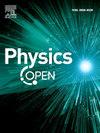Dynamical Systems describing matter dominating era in Modified Tele-Parallel Gravity
IF 1.4
Q2 Physics and Astronomy
引用次数: 0
Abstract
We investigate in the present paper, cosmological dynamical system describing matter evolution era under modified teleparallel theory of gravity. After reconstructing general cosmological dynamical system depending on the parameter which is function of the Hubble parameter, we explore three different cases of matter dominated era. First, we start with an antaz asymptotic value characterizing matter domination era. Secondly, the present work reveals two other new asymptotic values of the parameter , namely and corresponding to stiff matter evolution era at early time and dust matter evolution era at late time, respectively. This approach is based on Zel’dovich proposal according to what universe may be filled by stiff matter after inflation and before the radiation epoch. Under analytical and numerical analysis of the reconstructed autonomous dynamical system, the obtained stable fixed point of each evolution era, through its coordinates, leads to corresponding to phantom-like evolution with dark energy as candidate. This result confirms those existing in literature and suitably cited in this work. Furthermore, matter evolution era can be reached when the dynamical system is rendered non-autonomous. Our approach permits to challenge the reconstruction of models describing dark energy when scalar factor of stiff and dust matter is applied.
修正遥平行引力中描述物质支配时代的动力系统
本文研究了在修正遥平行引力理论下描述物质演化时代的宇宙学动力系统。在以哈勃参数为函数的参数m重构一般宇宙动力系统后,探讨了物质主导时代的三种不同情况。首先,我们从表征物质统治时代的反兹渐近值m=−9/2开始。其次,本文揭示了参数m的另外两个新的渐近值m=−2和m=−1/2,分别对应于早期的硬物质演化时代和后期的尘埃物质演化时代。这种方法是基于泽尔多维奇的建议,根据宇宙可能在暴胀之后和辐射时代之前被刚性物质填充。对重构的自主动力系统进行解析和数值分析,得到的每个演化时代的稳定不动点,通过其坐标,得到的ωeff<;−1对应于暗能量为候选的类幻演化。该结果证实了文献中存在的结果,并在本工作中适当引用。此外,当动力系统变得非自治时,物质演化时代就会到来。我们的方法允许对描述暗能量的f(T)模型的重建提出挑战,当使用刚性和尘埃物质的标量因子时。
本文章由计算机程序翻译,如有差异,请以英文原文为准。
求助全文
约1分钟内获得全文
求助全文
来源期刊

Physics Open
Physics and Astronomy-Physics and Astronomy (all)
CiteScore
3.20
自引率
0.00%
发文量
19
审稿时长
9 weeks
 求助内容:
求助内容: 应助结果提醒方式:
应助结果提醒方式:


